Affiliate marketing dates back to the 90s when people suddenly earned hundreds of thousands of dollars in commissions while businesses made substantial profits.
Today, Affiliate marketing is still one of the most profitable options for making money online.
As per Google trends (which measures interest in a keyword), in Jan. 2023, interest in the term “affiliate marketing” is a solid 100 on a scale of 100. Compared to this, the interest was at 47 back in January 2015.
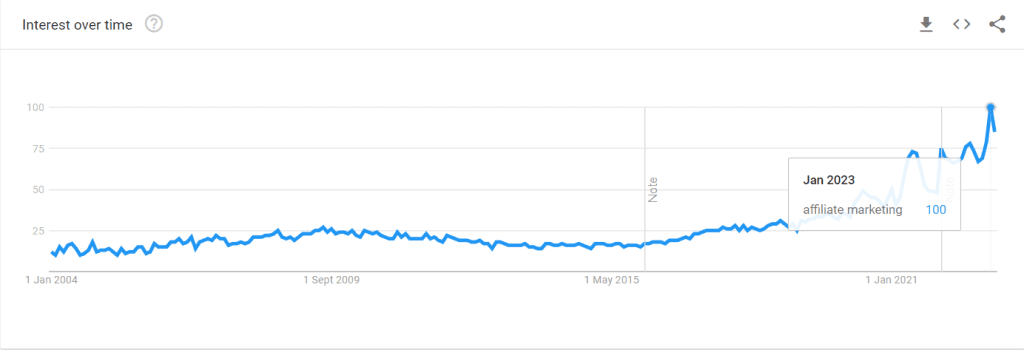
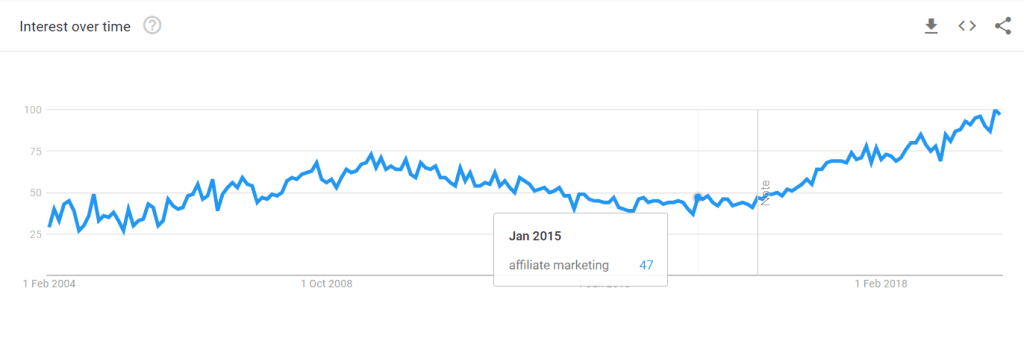
- As of 2023, the market value of Affiliate marketing is estimated at a mind-boggling $17 billion.
- Affiliate Marketing accounts for 16% of online orders in the US
- Approximately 80% of brands have a working affiliate program
- As per Backlinko, the most important client acquisition method for over 40% of US firms is Affiliate programs.
- Before purchasing, 74% of US internet consumers visit several affiliate websites.
What is Affiliate Marketing?
Affiliate marketing is promoting products in exchange for receiving a commission for each action taken. The advertiser does not pay for impressions or clicks but for results obtained.
Affiliates receive a commission when the visitor they have referred to the advertiser performs an action on their Website, whether filling out a form or making a purchase.
In other words, you get a cut when you generate sales for another company!
And the best part is that someone else has already worked hard to create the products, and you don’t have to use your resources, i.e., time and money.
As an affiliate, you can begin making $$$ as soon as you have a place to recommend the products, such as a website, a YouTube channel, a podcast, or even on social media.
How much can you earn from Affiliate Marketing?
Well, the sky’s the limit!

But not every affiliate marketer will achieve this level of success.
As per AuthorityHacker, as of 2023, on average, 15% of affiliate marketers earn between $80K to $1 million annually. And about 80% of them earn up to $80k.
There are certain factors on which your income from affiliate marketing depends, such as:
- Affiliate commission percentage for each sale
- Your audience sizes and the level of trust they have in your recommendations
- Typical commission percentages depend on the affiliate company and the affiliate products or services you promote. Usually, Digital products and services offer margins as high as 50% due to their lower production and fulfillment costs.
Brand-new affiliate marketers with decent website traffic can earn up to $1K per month, and once you get the hang of it, the possibilities are endless.
Caution: Beware of the Affiliate Gurus who prey on your hopes and dreams!
They rent a mansion and a flashy sports car and film themselves walking by the private swimming pool, telling you they have some secret but super easy “affiliate marketing system” which “anyone can do.”
The fact is, though, that they are actually broke. And their sole income source is selling useless courses, teaching you how to sell the same useless courses.
Oh, and yes, it takes 5 minutes to assemble those income statements they show you as their “proof of income.”
What are the benefits of Online Affiliate Marketing for Affiliates?
Due to the low barrier of entry, even a student can join an affiliate network, and at minimum one sale a month, they can still get paid $50 to $100.
There’s no location barrier in online affiliate marketing. An affiliate can promote an offer of a company in the UK to an audience in the US and earn an affiliate commission in the comfort of his home in Canada.
Also, you can start with free organic promotion methods such as content writing.
Moreover, today, Google AdSense is no longer a viable source of income due to extremely low EPM (Earning per thousand impressions). Similarly, on average, YouTube ads pay $1 to $1.5 per thousand views, i.e., for a million views on a YouTube video (that’s pretty hard to get), you make only $1K – $1.5 K.
In contrast, with affiliate marketing, if you have a million views on your YouTube video, you can expect 1% clicks (i.e., 10,000 clicks) on the description. If, from the clicks, 1% buy a product for $ 100 (with a commission of 30%), you can easily earn $3000 (two times the display ad revenue).
Thus, online affiliate marketing is an excellent way to earn to other traditional methods.
How Does Affiliate Marketing Work?
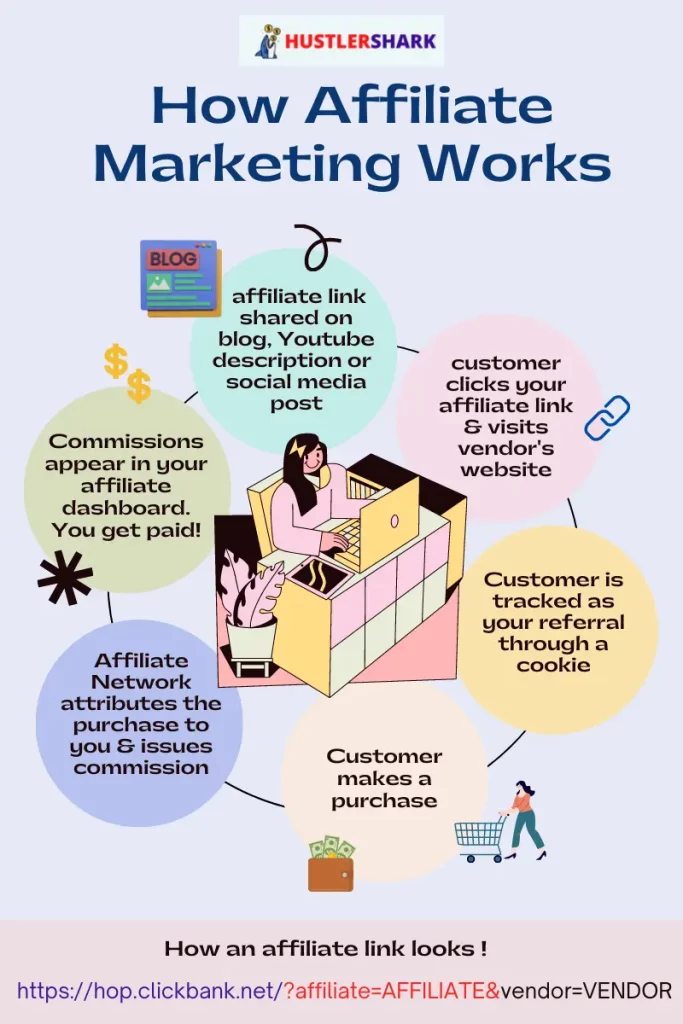
There are three main parties in an affiliate marketing system:
1. The Affiliate Marketers/ Publishers- You and your Web Property (website/YouTube channel/Podcast etc.)
2. The Affiliate company (or network)/ Merchant/ Vendor- You can promote a single company’s products or work with an affiliate network that connects You (the affiliate) with companies looking to promote their products or services. These networks often provide resources to help you, such as training, reporting tools, etc.
3. The Customer- Those who use your affiliate link to purchase a product/service from the affiliate company or network.
With the help of your web property such as blog, you, the affiliate marketer, recommend a product or service, say a course or tool such as vacuum cleaners. Through your recommendation, the affiliate company, say, Dyson, which produces vacuum cleaners, gets new customers they may not have found otherwise. Finally, when a sale to your audience happens, the company gives you a commission. Thus, all three parties in this relationship ultimately benefit – a Win-Win-Win situation.
In this arrangement, the most significant element for success is “Trust.
“If you can earn the trust of your audience by recommending affiliate products that you have used and believe your audience will benefit from, you can touch the sky.
Unfortunately, several people put income first rather than a serve-first approach giving affiliate marketing a bad reputation.
But thankfully, you can do it better, earning the trust of your audience, who will thank you for your genuine recommendations.
What are the popular Affiliate Marketing Models?
When talking about affiliate marketing models, we are referring to an agreement on what action with the ad will be paid for.
1. CPM or CPT: Cost Per Thousand means the affiliate advertiser pays a fixed amount per thousand unique impressions.
2. CPC: In the Cost Per Click model, which is used in display advertising (banners, clickable pop-ups, etc.), the affiliate advertiser pays only for impressions followed by clicks on the link/banner.
3. CPA: In Cost Per Action/ Acquisition, affiliates get paid when the user performs a desired goal on the advertiser’s site, i.e., for a conversion. Here, the conversion can be considered:
- For product purchase (Cost Per Sale or CPS)
- Leads, from the user’s mobile phone or email to the completed questionnaire (Cost Per Lead or CPL)
- App installation (Cost Per Install or CPI, usually used for mobile apps)
- other target actions include downloading a file, visiting a specific page, watching media, etc.)
4. Recurring Commissions: This one is my personal favorite. In this model, you sell the product once, and whenever the customer renews the product, you get a commission. For example, for hosting services or subscription-based products/ services, the affiliates are paid monthly when the customer renews the subscription.
This is probably the best model, but people consider it less because there’s no instant commission in most cases.
What are the most popular Affiliate Networks in the world?
To choose the right Affiliate Network, first consider what types of products and services your audience will likely be interested in.
For example, if your target audience is digital marketers, they are more likely to be interested in SEO tools than Health products. So, choose an affiliate platform that connects you with online tools and marketing platforms.
Here are some other considerations for choosing the best-suited affiliate networks:
- Affiliate Commission that you will earn per sale
- Approval requirements: Some networks are beginner friendly, while others require a well-established website or a certain amount of traffic.
- Other fees: Few networks charge fees for training or setup.
- Cookie duration: It refers to how long a program tracks and gives the affiliates credit for a prospective buyer. For example, the cookie duration for Amazon is 24 hours, while it’s 120 days for Avangate.
Building trust with your audience is most important to be a successful affiliate marketer. Never recommend products that you haven’t used or don’t love. Having said that, here’s a list that might be a starting point for finding an affiliate marketing program that suits you and your business.
1. ShareASale: Chicago-based affiliate network. Has been around since 2000. Can connect you with more than 4,000 programs. The interface can be a bit tough to use, but they offer training. Commission Rate- Varies as per merchant; averages between 5% and 20%. Product Types – Wide range, including accessories, clothing, art, computers, automotive, and even online dating services. Best For – New or established affiliate publishers looking to promote physical products.
2. Awin: Global affiliate network with access to more than 15,000 advertisers. Initially charge a $5 application fee which gets credited to your account if you are approved. Have to apply to each program separately. Commission Rate- Varies as per merchant, but averages around 5%. Product Types – Huge variety, including fashion, travel, finance, technology, insurance, and e-commerce. Best For – Newbies or established affiliate marketers.
3. Rakuten Advertising: A Japanese e-commerce brand providing affiliates access to hundreds of top brands, including, Lilly Pulitzer, Wells Fargo, Virgin Holidays, and Ecco. Commission Rate- Varies by the merchant. Product Types – Retail, finance, travel, Direct to Consumers, and more. Best For – Well-established affiliate marketers with stable traffic.
4. Avangate Affiliate Network: It connects Affiliates with digital goods merchants—think software companies and digital security companies like Malwarebytes. One of the longest cookie durations on the market (120 days) and allow affiliates to create coupons, helping drive sales. Reporting tools are a bit limited. Commission Rate- Minimum 25%; can reach over 50% for some merchants. Product Types – Digital products such as security and SaaS products. Best For – Affiliates in tech, business, SaaS, or related industries.
5. ClickBank: Global affiliate marketing platform providing access to a wide range of physical as well as digital ones. Not all available products are of high quality, so do check out products before you promote them. Commission Rate- Up to 90%, though most are much lower. Product Types – Wide variety, including fitness, business, marketing, arts and entertainment, games, parenting, health, languages, and self-help. Best For – All levels of affiliate marketers.
6. JVZoo: A massive affiliate network with more than 800,000 active affiliates. Most merchants are in the marketing, tech, and AI field. Commission Rate- Varies by the merchant. Product Types – Digital products in AI, online marketing, training, and financial fields. Best For – Affiliates in digital marketing, IT, and AI fields.
An affiliate marketing network such as ClickBank curates affiliate marketing programs for several brands and behaves like the middleman between the brand and the affiliate marketer.
Then there are self-hosted affiliate programs of individual brands that manage the program independently or with the help of dedicated affiliate managers. Here are some of the most popular ones:
Amazon Associates: It is the best-known affiliate network on the planet, providing access to millions of products from home décor to baby gear, makeup, and much more. They are strict about their T&Cs, and commission rates are lower than most other platforms. Affiliate commissions are usually low (from 1% to 10% in the case of luxury products) and vary by product type. On Amazon, you can promote almost any physical product you can think of, which is suitable for any affiliate marketer.
Hubspot: Commission- 100% of the first month’s revenue or 15% recurring. Ninety days of Cookie duration. Can promote their award-winning CRM platform — Marketing Hub, Sales Hub, CMS Hub, Operations Hub, and a powerful free CRM.
Elementor: It is a dynamic drag-and-drop WordPress website builder used to create more than 7% of all world’s websites—commission- 50% per sale and 45 days of Cookie duration.
AWeber: It’s an excellent tool for the newsletter and email drip campaigns and has been in business since 1998—commission- 30% lifetime recurring and 1 year of Cookie duration.
ConvertKit: It helps customers grow their client base via landing pages, forms, and email drip campaigns—commission- 30% lifetime recurring and 30 days of Cookie duration.
Fiverr: You can promote- Fiverr (freelance marketplace with digital services), Fiverr Learn (provides courses for freelancers and businesses looking to upgrade their skills), and Fiverr Pro (which provides access to hand-vetted talent). The commission is Fiverr CPA- $15-50, Fiverr Hybrid – $10 CPA + 10% RevShare, or 30% for every Fiverr Learn course order. The cookie duration is for 30 days.
Bluehost: Most famous web hosting affiliate program that offers an incredibly high fee as an affiliate commission. It is the go-to affiliate program for any business seeking to monetize its blog or Website—commission- $65 -$130 per sale and 45 days of Cookie duration.
Shopify: The most popular commerce platform allows you to start, grow, and manage an e-commerce business—commission- $150 USD for referrals to all full-priced plans and 30 days of Cookie duration.
Affiliate Marketing Guide for Beginners: Start Making Money in 7 steps
Step 1: Niche Selection
Your niche is the specific category you want to create content and promote. To achieve success fast, instead of tackling a broad niche like digital marketing, go for something narrower, like email marketing or hosting.
To find a suitable niche, ask yourself a few questions, such as-
- What are you good at?
- What do you like doing?
- What are you curious about?
- What do other people tell You that You are good at?
I can’t insist enough on the importance of choosing something that you’re passionate about. This is because you’ll need to create a lot of content to succeed and if you choose something you don’t like, it will get tough.
Step 2: Choose Your Content Platform
Decide your platform for reaching your audience.
There are several Platforms to choose from for Affiliate Marketing, such as:
- Website (Blogging, Microsites)
- YouTube
- Social media (e.g., TikTok, Instagram)
- Podcast
- Newsletter
- Email Marketing
Based on where your target audience hangs out, choose a suitable platform. For example, people who are interested in baking will prefer videos.
Also, since you have to create tons of content, you should enjoy creating content on that platform.
As per the top affiliate marketers building a website and using SEO (search engine optimization) to rank your content on Google is the most recommended strategy. This can generate consistent search traffic passively, which translates into a lot of clicks on your affiliate links and more $$$.
Step 3: Signup for a Suitable Affiliate Program
It’s essential to consider your niche and level of expertise.to choose the right affiliate programs.

For targeting consumers, choose low-paying, high-volume model affiliate programs such as amazon which has products with mass appeal.
For targeting businesses, go with high-paying, low-volume model affiliate programs which has niche products with fewer buyers, such as HubSpot. Popular programs include software and web hosting-related products.
Now, you must be thinking about how to find such affiliate programs.
It may sound simple, but a Google search is what it takes to find the top affiliate programs in your niche. Type “affiliate marketing programs” + your niche in the google search box.
For example, if you are in the dog training niche, google “affiliate marketing programs” + dog training, and so on.
If you know your direct competitors in your niche, you can find affiliate programs through referral links from other bloggers or affiliate sites.
Once you click the affiliate links of these competitors, you will be redirected to a product sales web page, where you can find the information about the affiliate program. Mostly you will find this information in the footer of the Website.
Alternatively, you can also find affiliate programs by looking for similar products. Don’t depend on just one affiliate program. Search other brands and products and check if they have similar affiliate programs.
Also, take a cue from popular Affiliate Marketing models and Affiliate Networks discussed above.
Step 4: Create Great Content to Generate Attention & Trust
This is a critical step to succeed in affiliate marketing. You have to create targeted and high-quality content based on the affiliate product you are promoting.
Your content must be helpful and solve your target audience’s problems or pain points. Keep them focused on their wants, goals, dreams, and desires.

Content can be videos, blogs, live webinars, etc.
It is also essential that your affiliate links fit naturally in the content and not the other way.

There are several types of content formats that you can use for your content. Here are a few to give you an idea.
Product Comparisons: Write in-depth product comparison articles to guide the audience to choose a product that best suits their needs. Include the products’ price key features, usability, and ratings.
Product Reviews: Write an in-depth review of the product based on your personal experience that is helpful and covers the key areas that most users search for, such as price, ease of use, support, pros, cons, etc.
Writing How-to Articles: This is a great way to teach people new skills or help them solve problems. For example, you can create content with in-depth instructions on “how to use Canva” or a detailed guide on “How to change the background from the image.” Such how-to-article should be detailed, easy to follow, and organized and should help people solve something in the shortest possible time.
While writing a how-to article, you can easily recommend an affiliate product that you think could be helpful for them.
Listicle Posts: These are List Posts. For example, “X best mobiles to buy under $1000” or “Y best email marketing tools for new bloggers .”Not only these list posts are easy to create, but they also convert more than reviews, how-to, or other posts.
To create one, you have to make a list of the best products or services. However, we recommend at least ten products in the List Post, so you don’t miss any.
Informational Videos: Creating text-based content is easier to produce, modify, and insert affiliate links, which is why most affiliate marketers prefer text-based content.
However, you can boost your text-based content by adding videos to your content. Videos are more engaging and convert more than text-based content.
Video Tutorials: Visuals are processed 60K times faster in the brain than text, and people retain 80 percent of what they see compared to only 20 percent of what they read.
So, videos are more engaging, and that’s why people love watching videos. Also, the video encourages people to take action. Thus, videos can be a great way to create content for affiliate marketing.
Social Media Content: The usage of social media has grown multi-fold in the last decade. Today social media, in one form or another, has become a daily part of almost everyone’s life. Have a look at the chart below:

With a global number of social media users being 4.76 billion and average user spending over 2.5 hours per day, social media platforms have become an essential affiliate marketing channel to promote your content.
One of the best things about social media platforms is that you can promote all content formats, such as videos, text, infographics, etc.
And while posting on social media platforms, don’t forget to check the posting guidelines for each individual platform as you will need to follow the rules of each site.
Here’s an example of social media content.
Another form of content is Webinars, Case Studies, and Coupon or Deal Pages.
To succeed as an affiliate marketer, you must be creative and produce tons of content. From listicle posts, how-to articles, and product reviews to webinars, ensure to cover all types of content on your affiliate site. This will lead to an increase in traffic which means more affiliate sales.
Step 5: Drive traffic: Promote your affiliate product or services
So, you’ve created high-quality content. The next step is to get eyeballs to this content, resulting in clicks on your affiliate links.
Broadly, traffic strategies can be divided into three categories.
Organic Traffic
This is the free traffic achieved by optimizing your content to rank high in search engines like Google (SEO), or by creating an engaging presence on social media platforms like Facebook, Instagram, Twitter, etc., that can increase organic traffic to your affiliate site.
SEO allows your content to appear at the top of search engine results. Until your content ranks high in the search engines for your target keywords, you’ll get passive and consistent traffic. Here’s a beginner’s guide from Ahrefs on Search Engine Optimization.
There are several hacks to generate traffic through an organic method, i.e., without using any paid promotion.
Here’s a detailed guide for achieving organic traffic to your content.
Paid Traffic
The traffic resulting from direct marketing is paid traffic resulting from a paid ad campaign or pay-per-click (PPC) ads. The most popular paid traffic source is Google Ads (formerly AdWords).
Some of the more popular ones are Paid Search Advertising, Social Media Advertising, Mobile Advertising, Native Advertising & Discovery Content, and Video Marketing.
While considering a traffic source for your affiliate content, it’s essential to understand specific parameters.
Organic traffic is more cost-effective, while paid traffic gives quick results. With organic methods, your content may take several months to rank and give consistent & passive traffic. Whereas paid traffic, though costly, can yield results in a few days.
Paid campaigns can result in fast but short-term conversions, whereas organic traffic is excellent for long-term ROI.
Paid campaigns are scalable and bring in traffic directly proportional to the budget invested, i.e., the more you invest, the more traffic is, but only until you invest in the ad budgets.
In contrast, organic traffic can keep highly qualified leads coming in for a long time and that too passively.
Besides, there are regulations & guidelines specific to the traffic source you use. Your knowledge of the right keywords is vital for succeeding in Paid traffic, and small mistakes can cost you dearly. Also, it is hard to compete with more prominent market players with unlimited budgets.
Email Marketing
Email lists are another popular way to share affiliate links with your audience.
Once you have traffic to your content, you can start building an email list, and send out weekly or monthly newsletters with built-in affiliate links to promote your affiliate offers. It is one of the long-term affiliate marketing strategies, and more on it later.
Affiliate marketers usually provide the audience with lead magnets, some incentive for signing up such as an eBook, a template, an email course, or free training.
Building an email link helps you as a marketer to communicate with your readers anytime. You can use the email list to inform your subscriber about new content. This helps keep them returning to you for more, leading to more affiliate clicks and sales.
You can even add your affiliate links in the emails, allowing you to make money when a subscriber clicks on a link and makes a purchase.
Step 6: Getting Clicks and Converting Clicks to Sales
Great content doesn’t guarantee clicks on your affiliate links resulting in sales.
Two conversions take place before you make money.
First is click to on the affiliate product page.
You must take care of three essential points for a reasonable click rate.
Placing your affiliate links at the bottom of the page or placing it everywhere in your content is a bad idea. Proper placement of affiliate Links in your content and balancing it with other factors below will yield better clicks.
Suppose you are writing a blog post on the best word press hosting providers for beginners.
Your intro shouldn’t look like this:
Here’s a list to choose the best word press hosting providers for those who have just started.
These links look spammy and out of context. Instead following would make better sense:
Here’s a list to choose the best word press hosting providers for those who have just started. These are hosting provider name 1, hosting provider name 2, hosting provider name 3, and hosting provider name 4.
Another important aspect is making your blog post more skimmable using buttons, boxes, tables, etc. These can help hold your reader’s attention for longer.
The second conversion is the reader purchasing the affiliate product.
The first conversion is under your control, and following the above points can lead to better click rates.
The second conversion is out of your control as the vendor, or the affiliate merchant controls the checkout.
So, finding affiliate merchants with products/ programs with reasonable conversion rates is crucial. Google for “income reports” for your affiliate product, where bloggers publicly reveal their affiliate income from that product. For example, if you search for “income report + Bluehost,” you’ll see the following as the top results:

The first result is from Pat Flynn’s Website, “Smart Passive Income,” and Pat Flynn is an authority in the Affiliate marketing space.
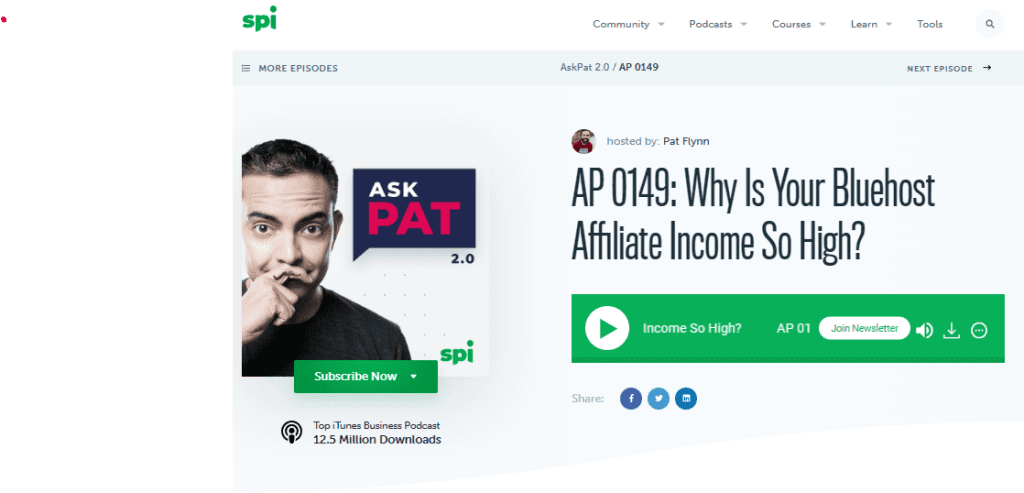
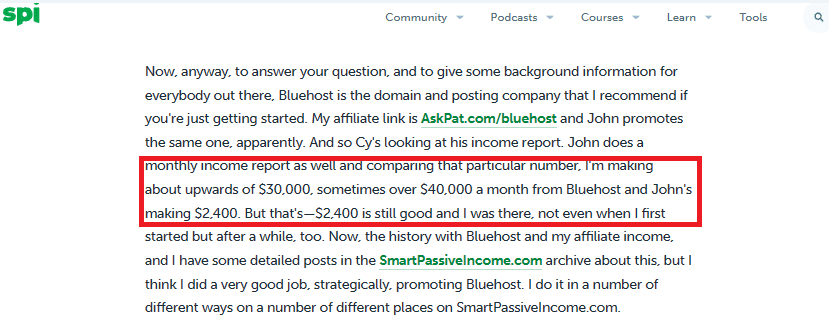
Suppose you cannot find sufficient information about the affiliate program. In that case, you want to join by the above method, sign up for the program, and ask them relevant questions about their average conversion rates and other doubts you have.
Here’s a Pro Tip.
Suppose you are using Click Bank as your affiliate marketplace.
Go to Click Bank, then pick the product URL you want to promote.
Go to Similar Web and look at the traffic. If the traffic is building steadily in good numbers, the affiliate product is hot and can be promoted well. It means it is trending, and people are sending traffic to this link and earning affiliate income.
Next, go to the reference sites. By doing this, we want to track the people promoting this offer on Click Bank. We see the domain names sending traffic to the primary domain name of the selected Click Bank affiliate product. Also, we want to know how they promote the offer, the landing pages they use, etc.
Pick one of the referral domain names, then click the icon that says Go to the Website.
If on pasting this URL in Google, you get a blank page, that does not mean that this URL is not sending traffic to Click Bank, but it means that the landing page is hidden.
Now how to see that hidden landing page?
We will use Google operators. Go to a new tab and type the site followed by the domain name, e.g., ‘sitewww.xyz.com.’
Now we may get many results. To narrow down the search further, we will use another Google modulator.
Type’ sitewww.xyz.com +keywords’. Keywords are the name of the product from Click Bank. Hit search, and the top result is a landing page used by the Website for the specific affiliate product you are looking to promote. Now copy the URL of this Website, go to Similar Web, and look at the traffic stats. If the traffic is good enough, this particular landing page is getting good traffic and must be getting good sales.
Step 7: Experiment and optimize your strategies.
The last step is experimenting with different strategies and seeing what works best for you.
There’s no one-size-fits-all solution, so trying different approaches and figuring out what works best for your niche and the products/services you’re promoting is essential.
The Technology Behind Affiliate Marketing
Each affiliate link looks like https://www.amazon.com/?affiliate=123.
Here 123 is the affiliate ID of the affiliate marketer. When the visitor clicks the affiliate link and lands on the page, there might be a purchase link or a lead form. When the visitor makes the payment or fills out the form and then goes to your Thank You Page, a “pixel” is fired on the Thank You Page, which lets the affiliate network or the advertiser know that desired action is completed. A pixel is a “1*1” invisible image that loads, and the loading of this pixel confirms the action.
The technology tracks the IP address, browser, and sometimes the user’s device. It also installs a cookie on the user’s browser, which helps track if the action is completed.
Different affiliate gives different cookie duration. Cookie duration in affiliate marketing refers to the duration for which you can potentially earn a commission after a visitor clicks your link, even if they don’t make a purchase immediately.
What are the Trends That May be Popular for Affiliate Marketing in 2023?
Following Affiliate marketing trends are expected in 2023:
- Artificial intelligence (AI) and automation will play a more significant role in every field of affiliate marketing- be it content creation or optimization.
- Video content will evolve and may overshadow blogs.
- Podcasts will play a more prominent role in affiliate marketing strategies.
- Voice and Virtual Search will further increase in popularity
Conclusion :
This post doesn’t try to reinvent the affiliate marketing wheel. These are the fundamentals, and applying them will get you started positively.
Don’t expect life-changing income or the freedom to quit your 9-5 overnight. Like any other business, Affiliate marketing also takes time.
Focus first on making your first affiliate sale. As your site grows, set new goals, and continue experimenting. This is how a good side hustle business eventually generates a decent income.
Read the following blog posts if you want to know about some interesting and practical Side Hustles or Passive Income sources:
9 side hustle ideas for earning fast money in 2023 % (hustlershark.com)


[…] Affiliate Marketing Guide for Beginners: How to Make Money in 2023 […]